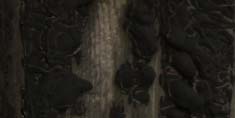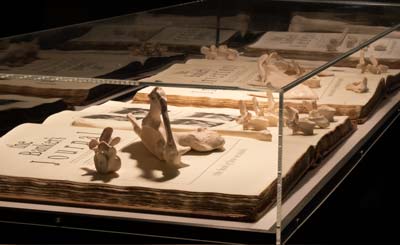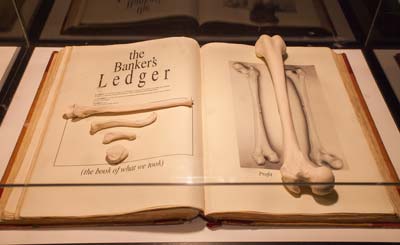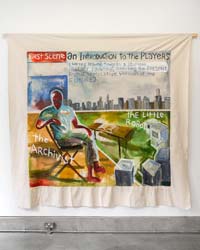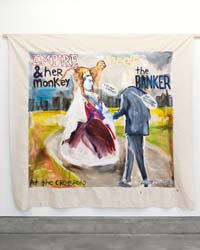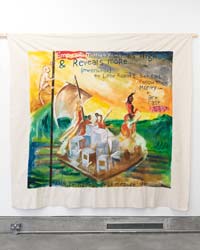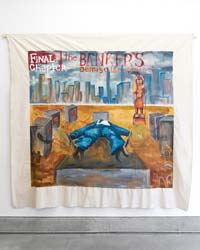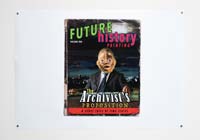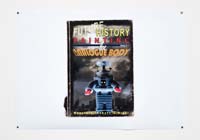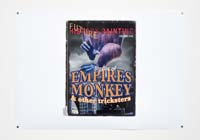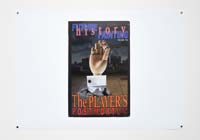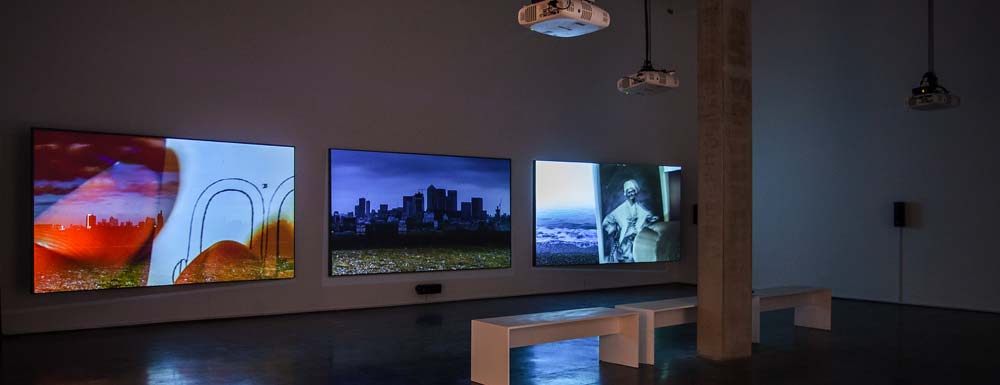
‘Unearthing the Bankers Bones’ is a project with multiple components. Its central element is a three-channel video installation with a narration that revisits key science fiction texts to reference contemporary issues and dialogues around migration, climate change and capitalism. It alludes to these issues through a fictional set of encounters between a shape-shifting ‘Trickster/Archivist’ figure and the ‘Banker’ of the title, depositing the Banker’s excavated ‘remains’ in a series of museum vitrines displayed in the gallery space under the title ‘The Bankers Books’.
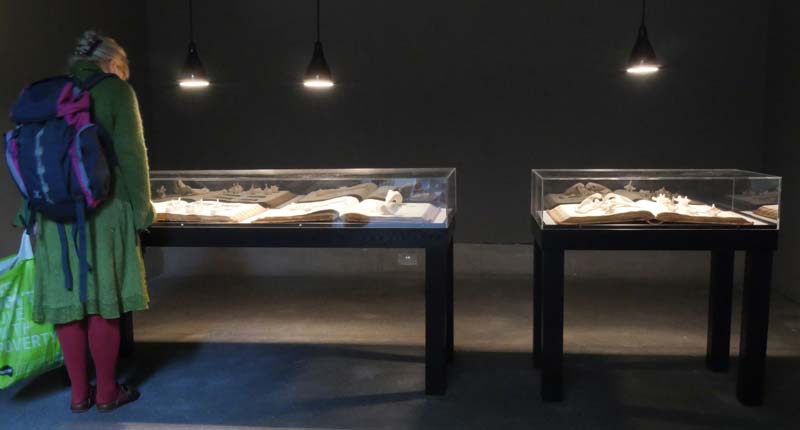
The place of the aesthetic and conceptual devices, themes and wider references employed in these works, in relationship to my wider art practice is explored in the Video Essay ‘Unearthing the Banker’s Bones: Notes on Tricksters and Robots’ premiered at the Tate Modern on 7th March 2017.
Core to my art practice has been an exploration of ‘narration strategies’, including metaphor, reportage and polemic, to structure commentary on social and political relationships. ‘Unearthing the Banker’s Bones’ deploys two diametrically opposed narration strategies; ‘speculative futurism’ (Science Fiction) and historicism (museology/history painting) to present a metaphorical exploration of capitalism, race and migration across four aesthetically disparate but thematically interlocking gallery-based installations.
Combined under the heading ‘Unearthing the Banker’s Bones’ within a touring solo exhibition, each of these installations deployed a distinct visual and aesthetic strategy to deposit ‘clues’ for the viewer to assemble and potentially derive meaning. This exploration of puzzle-solving is alluded to within the use of the term ‘Unearthing’ within the project title, gesturing towards an act of excavation on the part of the viewer through an active encounter with its multiple components.
The work references Octavia Butlers unfinished ‘Earthseed’ trilogy, in which two existing novels, ‘Parable of the Sower’ (1993) and ‘Parable of the Talents’ (1998) become eerily prophetic of the rise of religious fundamentalism and demagoguery in America under Trump. However, the third novel, projected to have been entitled ‘Parable of the Trickster’ remained unwritten at the time of Butlers death in 2006.
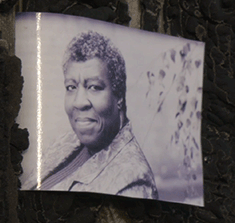
‘Unearthing the Bankers Bones’ speculatively morphs Butler’s unwritten ‘Trickster’, through Mary Shelley’s apocalyptic/survivor narrative ‘The Last Man’ (1826) into a reconfiguration of a figure called ‘Samannakin’ an ‘Android-Jinn’ taken from the final section of the epic ‘Islamo-futurist’ poem ‘BeYonDer’ by the Last Poets (1996). It is this ‘Trickster’ figure that confronts the ‘Banker’ to engage in a parodic and questioning critique of contemporary capitalism. The Trickster then evokes the science-fiction trope of ‘time-travel’ to leap into the future to excavate the banker’s tomb, shifting through and ordering his ‘relics’ to infer a new taxonomy of knowledge.
The second, related component of this project imagines the outcome of this act of excavation, displaying the ‘relics’ of the Banker in two museum vitrines containing the ‘Bankers Books’, three large volumes festooned with fragmented skeletal remains. These books, the ‘Ledger’, the ‘Journal’ and the ‘Inventory’ represent the classic information repositories through which the ebbs, flows and accumulations of capital are tracked and accounted for. The skeletal remains infer a process of fossilization, the consignment of these object to an implied deep history.
Alongside the language of museology deployed in the ‘Banker’s Books’, the processes and assumptions surrounding the act of ‘history painting’ are reimagined through the third installation of this project. ‘The Future History Painter’s Studio’ revisits and adds to the cast of characters introduced in the main installation in a series of semi-finished cartoon-like paintings alongside the tools of their production.
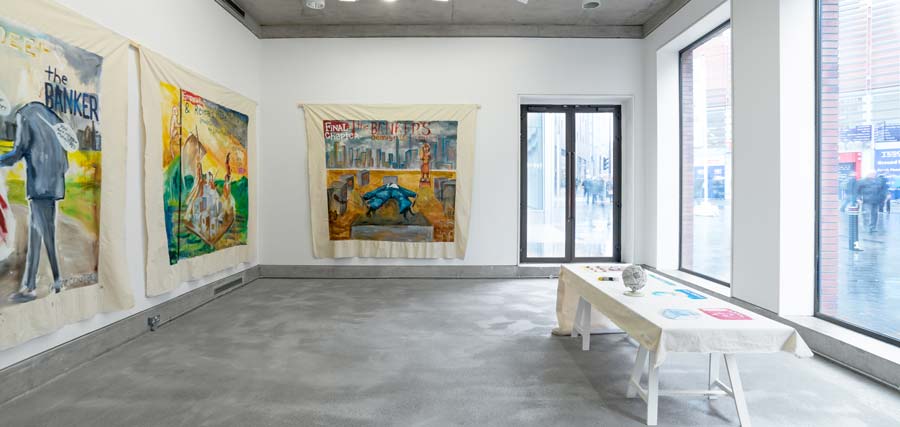
Within these large scale ‘working drawings’, the excavating ‘Trickster’ has taken on the persona of the ‘Archivist’ surrounded by a group of attentive ‘little robots’ (a reference to the project ‘Robot Bodies’ that formed another section of the exhibition). The ‘Banker’ is pictured meeting ‘Empire’ (and her monkey) in a restaging of Gustave Courbet’s 1854 painting ‘The Meeting’. ‘Empires Monkey’ appears again, this time cast adrift with the ‘Little Robots’ in a restaging of Theodore Gericault’s epic work from 1818-19 ‘The Raft of the Medusa’. The Banker returns in the final ‘drawing’, this time as a corpse surrounded by the little robots and a potential assassin figure, perhaps the latest manifestation of the shape-shifting trickster, this time into a form suggestive of a Benin figurine.
A table laid out with various tools and objects and painted signs is positioned in the centre of the space. No definitive code or index is offered to connect these objects, narratives and signs into a singular narrative. They are instead intended to gesture towards a potential set of readings, a puzzle-solving act of ‘unearthing’.
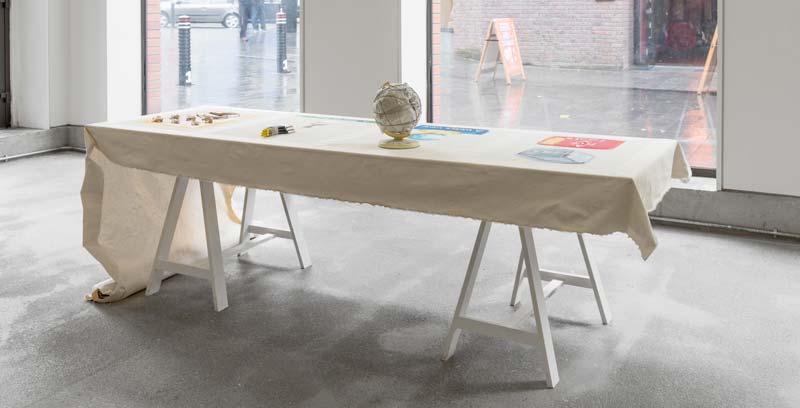
These acts of decoding the artwork through acts of excavation and puzzle-solving is extended into the fourth component of this project, a series of nine digital prints entitled ‘Pulp Fictions’ and forming a conceptual ‘bibliography’ for the project as a whole. Although aesthetically very different from the raw underworked visual language of the ‘history paintings’, these digital prints recall some of the main and supporting characters who appear in other parts of the project. This time, they are evoked as subjects of narratives inferred by the titles and texts appearing on the covers of well-thumbed and battered paperback books.
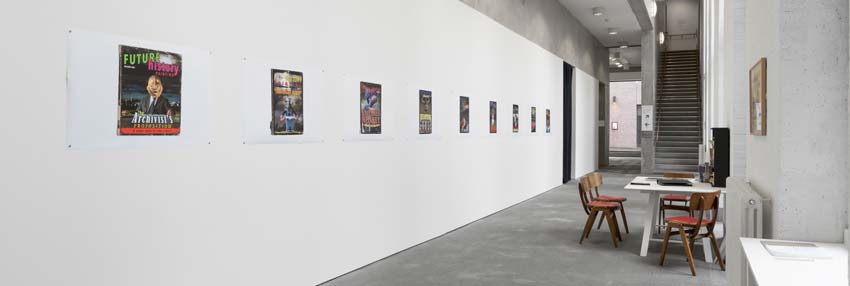
Under the serial title ‘Future History Painting’, we re-encounter the Archivist(Trickster) character, Empires Monkey, The Banker (this time referred to as the Player), Empire, the ‘Robot’ and other metaphorical tropes that hint towards an overlapping set of narratives that is inferred but never concertized across the multiple components of this project.
The short interview-based documentary ‘Keith Piper: Unearthing the Bankers Bones’ by Charles Havord (commissioned by InIVA and the Bluecoat Liverpool) provides further insight into the production of multiple components of this project.





